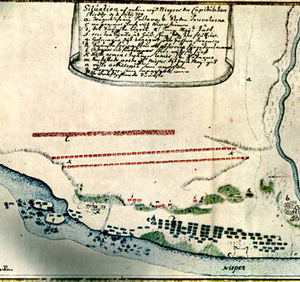| Perevolochna | |||||||
|---|---|---|---|---|---|---|---|
| Part of the Swedish invasion of Russia | |||||||
 Map depicting the surrender. Red=Russians and blue=Swedes. In the bottom left, Charles XII crosses the Dnieper along the two islands. Perovolocna is to the right, next to the Vorskla River. | |||||||
| |||||||
| Belligerents | |||||||
|
|
| ||||||
| Commanders and leaders | |||||||
|
Adam Ludwig Lewenhaupt | Alexander Menshikov | ||||||
| Strength | |||||||
| 12,000[1]–20,000[2][3][a] | 9,000[2]: 231 [b] | ||||||
| Casualties and losses | |||||||
| Entire army captured[2]: 246 [1]: 710 | |||||||

The surrender at Perevolochna was the capitulation of almost the entire Swedish army on 30 June 1709 (O.S.) / 1 July 1709 (Swedish calendar) / 11 July 1709 (N.S.). It signified the virtual annihilation of the once formidable Swedish army after the defeat at Battle of Poltava, and paved the way for the eventual Russian victory in the Great Northern War. After the Battle of Poltava, Charles XII escaped to Moldavia, a vassal state of the Ottoman Empire.
- ^ a b Cite error: The named reference
Tuckerwas invoked but never defined (see the help page). - ^ a b c d Cite error: The named reference
Englundwas invoked but never defined (see the help page). - ^ Егоршина 2023, p. 739.
- ^ Bodart 1908, p. 159.
- ^ Егоршина 2023, p. 69.
Cite error: There are <ref group=lower-alpha> tags or {{efn}} templates on this page, but the references will not show without a {{reflist|group=lower-alpha}} template or {{notelist}} template (see the help page).